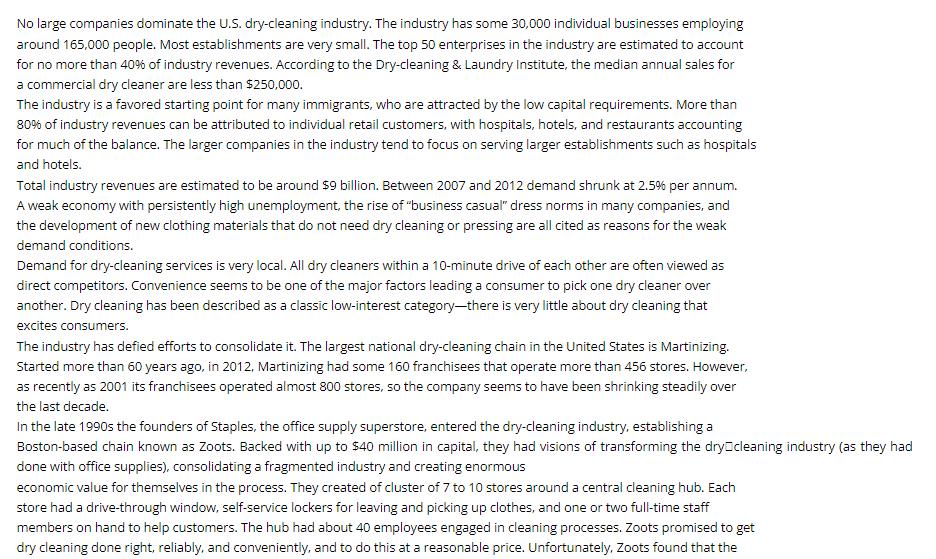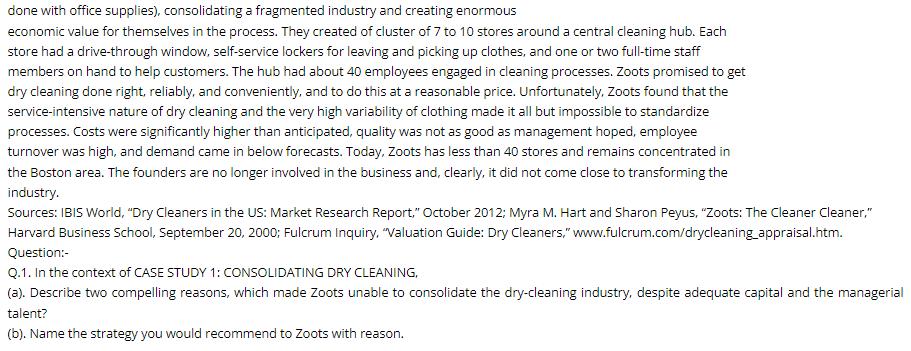Answered step by step
Verified Expert Solution
Question
1 Approved Answer
No large companies dominate the U.S. dry-cleaning industry. The industry has some 30,000 individual businesses employing around 165,000 people. Most establishments are very small.


No large companies dominate the U.S. dry-cleaning industry. The industry has some 30,000 individual businesses employing around 165,000 people. Most establishments are very small. The top 50 enterprises in the industry are estimated to account for no more than 40% of industry revenues. According to the Dry-cleaning & Laundry Institute, the median annual sales for a commercial dry cleaner are less than $250,000. The industry is a favored starting point for many immigrants, who are attracted by the low capital requirements. More than 80% of industry revenues can be attributed to individual retail customers, with hospitals, hotels, and restaurants accounting for much of the balance. The larger companies in the industry tend to focus on serving larger establishments such as hospitals and hotels. Total industry revenues are estimated to be around $9 billion. Between 2007 and 2012 demand shrunk at 2.5% per annum. A weak economy with persistently high unemployment, the rise of "business casual" dress norms in many companies, and the development of new clothing materials that do not need dry cleaning or pressing are all cited as reasons for the weak demand conditions. Demand for dry-cleaning services is very local. All dry cleaners within a 10-minute drive of each other are often viewed as direct competitors. Convenience seems to be one of the major factors leading a consumer to pick one dry cleaner over another. Dry cleaning has been described as a classic low-interest category-there is very little about dry cleaning that excites consumers. The industry has defied efforts to consolidate it. The largest national dry-cleaning chain in the United States is Martinizing. Started more than 60 years ago, in 2012, Martinizing had some 160 franchisees that operate more than 456 stores. However, as recently as 2001 its franchisees operated almost 800 stores, so the company seems to have been shrinking steadily over the last decade. In the late 1990s the founders of Staples, the office supply superstore, entered the dry-cleaning industry, establishing a Boston-based chain known as Zoots. Backed with up to $40 million in capital, they had visions of transforming the dry cleaning industry (as they had done with office supplies), consolidating a fragmented industry and creating enormous economic value for themselves in the process. They created of cluster of 7 to 10 stores around a central cleaning hub. Each store had a drive-through window, self-service lockers for leaving and picking up clothes, and one or two full-time staff members on hand to help customers. The hub had about 40 employees engaged in cleaning processes. Zoots promised to get dry cleaning done right, reliably, and conveniently, and to do this at a reasonable price. Unfortunately, Zoots found that the done with office supplies), consolidating a fragmented industry and creating enormous economic value for themselves in the process. They created of cluster of 7 to 10 stores around a central cleaning hub. Each store had a drive-through window, self-service lockers for leaving and picking up clothes, and one or two full-time staff members on hand to help customers. The hub had about 40 employees engaged in cleaning processes. Zoots promised to get dry cleaning done right, reliably, and conveniently, and to do this at a reasonable price. Unfortunately, Zoots found that the service-intensive nature of dry cleaning and the very high variability of clothing made it all but impossible to standardize processes. Costs were significantly higher than anticipated, quality was not as good as management hoped, employee turnover was high, and demand came in below forecasts. Today, Zoots has less than 40 stores and remains concentrated in the Boston area. The founders are no longer involved in the business and, clearly, it did not come close to transforming the industry. Sources: IBIS World, "Dry Cleaners in the US: Market Research Report," October 2012; Myra M. Hart and Sharon Peyus, "Zoots: The Cleaner Cleaner," Harvard Business School, September 20, 2000; Fulcrum Inquiry, "Valuation Guide: Dry Cleaners," www.fulcrum.com/drycleaning_appraisal.htm. Question:- Q.1. In the context of CASE STUDY 1: CONSOLIDATING DRY CLEANING, (a). Describe two compelling reasons, which made Zoots unable to consolidate the dry-cleaning industry, despite adequate capital and the managerial talent? (b). Name the strategy you would recommend to Zoots with reason.
Step by Step Solution
★★★★★
3.38 Rating (151 Votes )
There are 3 Steps involved in it
Step: 1
a Zoots faced two main challenges in its attempt to consolidate the drycleaning industry Firstly the serviceintensive nature of drycleaning and the hi...
Get Instant Access to Expert-Tailored Solutions
See step-by-step solutions with expert insights and AI powered tools for academic success
Step: 2

Step: 3

Ace Your Homework with AI
Get the answers you need in no time with our AI-driven, step-by-step assistance
Get Started


